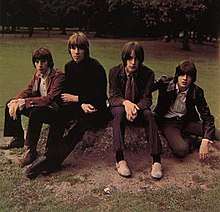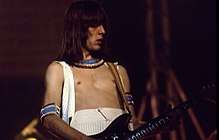Nazz
The Nazz was an American rock band formed in Philadelphia in 1967. They were founded by guitarist and principal songwriter Todd Rundgren and bassist Carson Van Osten.[3] Drummer Thom Mooney and vocalist/keyboardist Robert "Stewkey" Antoni joined before their first concert, opening for the Doors in 1967. They are best known for their debut single "Open My Eyes" backed with "Hello It's Me".
Nazz | |
|---|---|
 Nazz, 1968 | |
| Background information | |
| Origin | Philadelphia, Pennsylvania, United States |
| Genres | |
| Years active |
|
| Labels | SGC |
| Past members | Todd Rundgren Carson Van Osten Thom Mooney Robert "Stewkey" Antoni |
Their name was derived from the Yardbirds' song "The Nazz Are Blue". Although the use of a definite article was intended, the band was credited simply as "Nazz" on their records and promotional materials. Between 1968 and 1970, Nazz released three albums (Nazz, Nazz Nazz, and Nazz III). Following the group's disbandment in 1969, Rundgren pursued a solo career, and in 1972, recorded a new version of "Hello It's Me" that reached number 5 on U.S. charts.
Name and formation
The Nazz took its name from the Yardbirds' song "The Nazz Are Blue" on their 1966 album Roger the Engineer. In 1952, the American comedian Lord Buckley recorded a popular monologue, "The Nazz", which is a re-telling of the story of Jesus of Nazareth.[4] Rundgren stated in an interview that the group was not aware of Lord Buckley's monologue.
Their name on all records and press materials is simply "Nazz", without the definite article. However, the group is commonly referred to as "the Nazz". Rundgren stated that "We were formed in the late sixties, so most every band was the something. It was always 'the This' or 'the That,' so we were looking for some the thing to be something kind of simple and iconographic, I guess."[5] In their song "Loosen Up", they introduce themselves as "the Nazz, from Philadelphia."[6]
In Phoenix, Arizona, another band called Nazz was formed at about the same time that Nazz was formed in Philadelphia. This group released only one single before moving to Los Angeles and renaming themselves Alice Cooper.[7]
Nazz and "Open My Eyes"
Nazz was marketed by their original manager, Michael Friedman, as a teenybopper band along the lines of the Monkees. The group signed with SGC Records, releasing Nazz in October 1968.[3] The album was not commercially successful and neither was the first single, "Open My Eyes" of which the flip side was "Hello It's Me" (#41 Canada). "Open My Eyes" was the side SGC Records was promoting, but in Boston WMEX Music Director and DJ Ron Robin accidentally played the flip side. He was impressed and added it to the station's playlist. Reaction was strong and "Hello It's Me" became a number one hit at WMEX in 1968. Several weeks later it was on the playlist of Boston's other Top 40 radio station WRKO and eventually at other stations across the country. SGC Records presented Ron Robin with a Silver Record which reads "WMEX, Where it All Began. Thanks!".
Nazz gained exposure in Philadelphia in the summer of 1969 and into the fall of 1969 through the winter of 1970 when "Hello It's Me" then "Open My Eyes" became frequently played on WMMR 93.3 in Philadelphia driven by DJ Michael Tearson. The song's music video is directed by horror and thriller movie director Ray Dennis Steckler and released in 1968.
Nazz Nazz and Nazz III
After a brief trip to England in October 1968, cut short by visa problems, Nazz recorded their second album, originally entitled Fungo Bat, in Los Angeles in late 1968 and early 1969. (A fungo bat is a special baseball bat used only for practice; it is not intended to hit pitched balls.) The album was originally intended as a double album but was shortened to a single LP before being released as Nazz Nazz in May 1969.[3] Much of what was cut was experimental, piano-based Rundgren material, heavily influenced by singer/songwriter Laura Nyro - a far cry from the group's original Beatles-Who-Yardbirds-Cream derived sound.[3] Disillusioned, Rundgren departed the group, along with Van Osten, soon after.[3]
The Move — one of Nazz's main influences — played "Open My Eyes" and "Under The Ice" during live sets in 1969, as documented on the version recorded at the Fillmore Auditorium included on 2008's The Move Anthology. Rundgren commented in 2018 that he was unaware of this until that album was released. The band continued to tour during the rest of 1969, recruiting Craig Bolyn (guitar) and Greg Sempler (bass). Mooney departed at the end of the year, but Stewkey continued to tour in 1970 using the Nazz name. In 1971, without the full band's knowledge or consent SGC released Nazz III, in which most of Rundgren's vocals from the old 'Fungo Bat' tapes were replaced by Stewkey.
Solo careers and legacy

Rundgren had a successful career as a solo artist and with the band Utopia. His biggest solo hit was an up-tempo version of "Hello It's Me", from his 1972 Something/Anything? album, which peaked at #5 on the Billboard Hot 100 on 22 December 1973. Carson had a successful career at Disney, living in Southern California with his family. Stewkey and Mooney reconnected and played with Fuse for a brief period using two monikers, Fuse or Nazz, depending on where they were gigging. Mooney would leave again, and Fuse evolved into "Sick Man of Europe", and later (without Stewkey) Cheap Trick.[8][9] Mooney eventually played with a variety of groups including Rita Coolidge's band, where he served as drummer and musical director, Roger McGuinn, John Hiatt, Curtis Brothers, Tattoo, and Paris.
The Nazz proved influential on the emerging genre dubbed power pop.[10] They gained wider recognition thanks to the inclusion of "Open My Eyes" on Nuggets (1972), an anthology of American 1960s garage punk and psychedelia compiled by musician Lenny Kaye. The three Nazz LPs were reissued by Rhino Records on LP in 1983 and subsequently on CD with bonus demo and outtake tracks. In 2009, Spectra Records released three albums by Nazz. They were Nazz vs. Toddzila, 13th and Pine, (compilation) and Hello It's Crazy Me. In 2011, the Bangles recorded "Open My Eyes" on their album, Sweetheart of the Sun.
In popular culture
- Nazz is featured on the soundtrack of The Mad Room, a 1969 horror movie directed by Norman Maurer.[11]
Members
- Todd Rundgren - guitar
- Carson Van Osten - bass guitar
- Robert "Stewkey" Antoni - vocals, keyboards[12]
- Thom Mooney - drums
Discography
Studio albums
| Year | Information |
|---|---|
| 1968 | Nazz
|
| 1969 | Nazz Nazz
|
| 1971 | Nazz III
|
Compilation albums
| Year | Information |
|---|---|
| 1984 | Best of Nazz |
| 1998 | Thirteenth and Pine
|
| 2002 | Open Our Eyes: The Anthology
|
| 2006 | Nazz Nazz - Including Nazz III - The Fungo Bat Sessions
|
Singles
| Year | Title | Chart positions | Album | |
|---|---|---|---|---|
| US Billboard Hot 100 | CA RPM Charts | |||
| 1968 | "Open My Eyes" | 112 | – | Nazz |
| 1969 | "Hello It's Me" | 66[15] | 39[16] | |
| "Not Wrong Long" | – | 90[17] | Nazz Nazz | |
| "Some People"[18] | – | – | Nazz III | |
References
- Marky Ramone; Richard Herschlag (13 January 2015). Punk Rock Blitzkrieg: My Life as a Ramone. Simon and Schuster. p. 76. ISBN 978-1-4516-8779-8.
- Patricia Romanowski Bashe; Patricia Romanowski; Holly George-Warren; Jon Pareles (1995). The New Rolling Stone Encyclopedia of Rock & Roll. Fireside. p. 695. ISBN 978-0-684-81044-7.
- Colin Larkin, ed. (1997). The Virgin Encyclopedia of Popular Music (Concise ed.). Virgin Books. p. 890. ISBN 1-85227-745-9.
- Evans, Paul. "The Nazz." The Rolling Stone Album Guide. Ed. Anthony DeCurtis and James Henke with Holly George-Warren. New York: Random House, 1992. 497.
- Kjellmer, Göran; Aijmer, Karin (2001). A wealth of English: studies in honour of Göran Kjellmer. Acta Universitatis Gothoburgensis. ISBN 978-91-7346-398-0.
- Nazz III (Audio). Nazz. SGC Records. 1970.CS1 maint: others (link)
- Archived September 17, 2011, at the Wayback Machine
- "Nazz biography". Technicolor Web of Sound. Retrieved 2014-09-01.
- "Cheap Trick line-up history". Classicwebs.com. Archived from the original on 2014-10-24. Retrieved 2014-09-01.
- Earles, Andrew (September 7, 2002). "Power Pop: The '70s, The Birth Of Uncool - Magnet Magazine". magnetmagazine.com.
- Michael Weldon. The Psychotronic Encyclopedia of Film. London: Plexus, 1983, p. 444
- The Nazz at AllMusic
- "Miscellaneous Atlantic-Distributed Labels". Bsnpubs.com. 2005-09-25. Retrieved 2014-08-22.
- "Rhino Album Discography, Part 2". Bsnpubs.com. 2004-07-25. Retrieved 2014-08-22.
- "Billboard Hot 100 - Nazz". Retrieved December 5, 2017.
- "RPM Charts - January 20, 1969". Retrieved December 5, 2017.
- "RPM Charts -April 28, 1969". Retrieved December 5, 2017.
- "The Nazz - Some People / Magic Me - SGC - USA - 45-009". 45cat. Retrieved 2014-08-22.